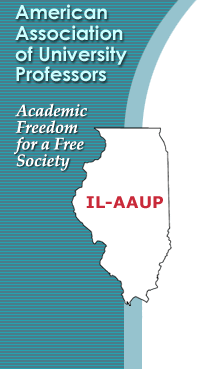Home | IL Academe | About IL AAUP | Conference Corner | Calendar | Services | Committees | Contact Us | Grants | Reports | Links
 |
 |
 |
AAUP Annual Job Survey While the Great Recession may be technically over in the broader US economy, the same cannot be said in the higher education sector. The results of the American Association of University Professors’ annual survey of full-time faculty compensation are only marginally better than last year’s and represent the continuation of a historic low period for faculty salaries. For the second consecutive year, the overall average salary level increased at a rate less than inflation. And this is the fifth of the last seven years in which overall faculty salaries declined in purchasing power. With three full years of data now available, we can begin to assess the direct impact of the recession on faculty compensation. This year's report examines two major aspects of the recession's impact: the ongoing expansion of contingent academic employment and growing salary inequality, both within the faculty and between faculty members and college and university presidents. We released It’s Not Over Yet: The Annual Report on the Economic Status of the Profession, 2010–11 today. The complete report (including the institutional listings of average salary by rank and gender and aggregate tables for comparison) is available on our website. AAUP members will also receive a hard copy of this year’s report in the mail as part of their member subscription to Academe. In addition to listing average salary by faculty rank and gender at more than 1,300 colleges and universities, the report provides an important perspective on the economic challenges facing higher education. Here are some highlights:
Even with the substantial impact of the recession already documented in this analysis, our forecast for the near future is not encouraging. States will continue to have reduced revenue, and that means decreased state funding for the majority of public-sector institutions. At the same time, governors in a number of states have been using the fiscal crisis as a pretext for a broad attack on public-employee compensation. AAUP chapters can initiate (or continue) a conversation about compensation on their campuses by ordering one or more peer compensation reports, which provide a comparison of salary and benefits among specific institutions. We encourage you and your colleagues to take the initiative to find out more about the situation on your campus, and to get involved in decision making. If you haven’t already seen them, check out our “Financial Crisis FAQs.” These questions and answers can help you make the case for focusing resources where they are needed most: on the core mission of teaching and scholarship. The financial challenges for higher education are not going away any time soon, and it’s up to us to make sure that budget cuts don’t damage the most valuable resource in higher education: you, the teachers, scholars, advisors, activists, and mentors. In these challenging times, we need as many defenders of higher education as we can muster. If you’re already a member of the AAUP, thank you. We hope that this information helps you advocate for quality on your campus. If you’re not a member of the AAUP, please join us in our work—you already know how important it is, and we’ll be stronger with the addition of your ideas and your experience. In either case, if you have questions, comments, or suggestions about this report, please do let us know (aaupfcs@aaup.org). This is always a busy time of year, but we try to respond to every message. We look forward to hearing from you.
|
|